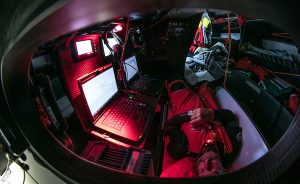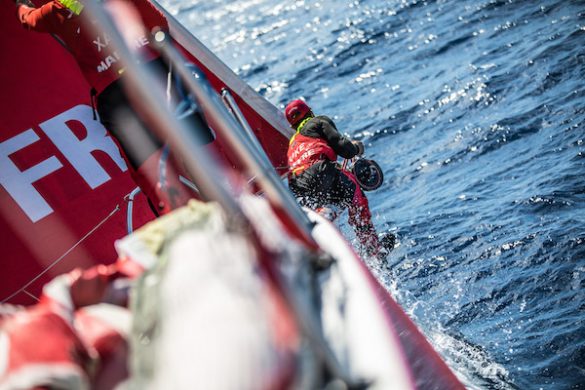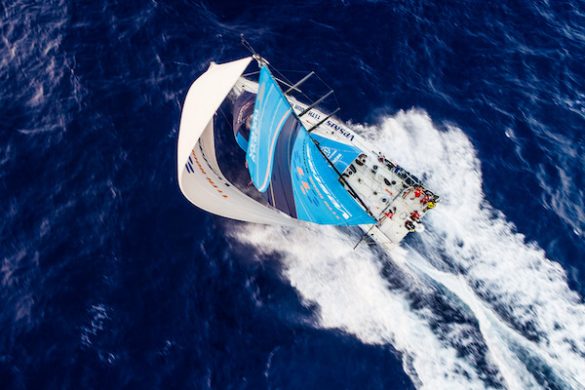South African Simon Botes was able to live his dream working at the Ocean Race Boatyard during the 2017/2018 edition of the race. He shares his experiences and lends insight into the behind-the-scenes workings of this crucial maintenance hub.
I started sailing catamarans, at the relatively late age of 12, from Fish Hoek Beach Sailing Club, winning some youth sailing trophies. Later I progressed to yachts and competed in both ‘round-the-cans’ and offshore events, which sparked my interest in onboard hardware and winch systems.
On the recommendation of my friend Hylton Hale, I got the opportunity to work at Harken SA – it turned into a job I enjoyed for nine years. I worked on projects where I specified hardware and winch systems, from dinghies and race boats to superyachts.
This position allowed me to learn the ins and outs of the industry and helped pave the way for an incredibly satisfying career in yachting. The owner of the business, the late Ankie Roux, became both my mentor and friend. Through Harken, I met and worked alongside the company’s tech team on the very extreme Volvo 70s at the Cape Town stopovers for two editions of the Volvo Ocean Race, 2008-09 and 2011-12. The bug bit as these were boats that I had only ever seen in photographs and on YouTube videos, and I had always yearned to work on bigger and faster race boats.

Leg 4, Melbourne to Hong Kong, day 12 Ben Piggott on the runner winch on board Sun Hung Kai/Scallywag. Photo by Konrad Frost/Volvo Ocean Race. 13 January, 2018.
I moved to Harken UK in 2014 and was employed as a technician for the duration of the 2014-15 Ocean Race. This was the first edition of the race that featured the purpose-designed Volvo 65. This one-design fleet made it possible to optimise the servicing of each boat, which became necessary as the maintenance period of the stopovers became increasingly shorter. The feeling was that the boats should spend more time on the water in the Race Village and not ‘on the hard’ being serviced and away from the public eye. The teams were expected to engage in quite a few more corporate- or exhibition-style races and this added extra pressure to the service teams to turn the boats out faster. This centralised servicing system reduced overall costs for each team too.
Aside from a few superyacht transatlantic deliveries, I also worked for Groupama Team France in the 35th America’s Cup. I was brought in for a three-month contract to install and optimise the winch and pedestal system on their America’s Cup test boat. I was based in Lorient, France, but I spent one month at the Multiplast factory in Vannes and another month at the then-secret testing facility in Lanvéoc.
Then I joined the Ocean Race Boatyard service team in Lisbon for a refit of the fleet of Volvo 65s, later staying on as a member of this team for the 2017-18 edition of the race, primarily working on winches and drive systems. I worked in the deck-gear department as part of the two-person team who uninstalled, serviced, upgraded and reinstalled deck gear. We stuck to this servicing system for each boat at every stopover.
The service for each boat included checking each of the items below and, where necessary, replacing or servicing them (changing gear oil, cleaning parts, etc.):
• Three deck hatches
• Four-cam cleats
• Eight Harken winches (with an average working load of five tonnes each)
• Eight Harken foot blocks
• 24 Spinlock rope clutches
• More than 50 Wichard folding pad eyes
I was also a refit boat captain, responsible for following two of the seven boats during the refit process, making certain that every part that was removed from the yacht was catalogued and stored, ready for its phase of the refit, whether it went directly off to the paint booth or to the electronics department or into the deck-gear workshop for a full service and refit.
I am settled in Palma now and freelance, and have just completed servicing the winch and pedestal systems for both of the SA-flagged Phoenix TP52s. (Read about their campaign success on page 36 of S+L issue 4.)
HOW DOES THE BOATYARD WORK?
The Boatyard concept was introduced for the 2014-15 edition of the Volvo Ocean Race to take care of the tuning, repair and maintenance of the competing yachts. It was made possible by the one-design concept of the Volvo 65.
For the first time, the maintenance facility was a shared one, fully stocked with all the parts and equipment required and knowledge on hand to get every boat back into perfect race condition at each and every stopover.
Another innovation was to open the maintenance facility to the public, with viewing platforms that allow fans the opportunity to see firsthand the specialist work that is done in this 1 200m2 facility – from the sails being scrutinised and maintained, to the rigs being dismantled, checked and rebuilt.
Witnessing the Boatyard in action provides a unique insight into the complexity and nature of the racing machines and the race. It’s here that the spectator can see the pounding that these boats take from the big waves.
At the end of almost every leg, the boats go through a significant maintenance programme.
All the mechanical parts need a full check and service, the winches are stripped and rebuilt, rudder and keel mechanisms are dismantled and checked… the list goes on, with hundreds of hours of work involved in getting each boat prepared for each restart. And that’s assuming that there is nothing broken or damaged that needs to be replaced or repaired.
Source: volvooceanrace.com/en/boat/35_The-Boatyard.html

Leg 4, Melbourne to Hong Kong, Day 2 onboard Turn the Tide on Plastic. Photo by Brian Carlin/Volvo Ocean Race. 03 January, 2018.
THE CHALLENGES OF GETTING IT RIGHT EACH TIME
Harken was the official supplier of deck hardware to the Ocean Race for the 2017/2018 edition ensuring that the fleet had the very best and most reliable equipment for the duration of the race. sail-world.com spoke to Mark Gardner, custom projects and service manager at Harken UK, during the Cardiff stopover to find out more.
What does your job entail when the boats get ashore?
The most difficult part for us is maintaining the consistency, ensuring that the service is right for every boat. We split it up, looking at the number of miles that the boats do at different stopovers. You can compare it to car service – different levels of service are provided depending on the number of miles covered. We have A+, A, B and C services.
An A+ service happened ahead of the race during the refit and assembly period in Lisbon, and it also happened again in Auckland, which is basically halfway through the race. This A+ service includes taking the winches, all the pedestal systems, and the drive shafts and gearboxes off the boat and to the container to be serviced, cleaned and inspected before being put back on. Everything that suffers from wear and tear is changed out and is proactively serviced before we have any problems: all the pawl springs, washers and seals will be changed out. An A service won’t have so many parts changed out and we’ll inspect the gearboxes on board unless we see something that might be a problem. In Cardiff, we performed an A service.
During a stopover, is it a challenge time-wise to get this all done for the seven teams?
Very much so. We only had five days in Cardiff. During the 2014-15 edition of the Ocean Race, it was our first time working this way with the Boatyard and that was very challenging. But this time it was easier as we knew what to expect. I have a formula for how long we’ve got and how many people it will require to get the work done in the allocated time. The problem for us is the unknown amount of time we will have to work on each boat: the date that the boats leave on the next leg never changes, but the date that the boats arrive at a stopover is variable. I’m constantly in contact with Neil Cox and Nick Bice in the Boatyard to look at the ETAs, making a call quite close to the end of the leg, saying, ‘We have this amount of time; this is how many people we’ll need.’ At times, it’s really challenging. Brazil was probably the biggest challenge in this race as two yachts came in very late. The timeline was to lift the boats out, complete the servicing and put them back in the water just 30 hours later. From our point of view, this was very difficult as the winches are needed to balance the boat when lifting the boats out. Then the structural team has to check that they are happy with the structure. During this process, they might need to lift the boats to move them around in the cradle, which again requires the use of the winches. We had to do two days’ work overnight, starting at 6 pm and finishing at 4 am.
So, while the winners are on the stage popping the champagne, you’re there stripping the boats down?
As soon as the boat is loaded into the cradle, we’re there with our blue buckets. Each bucket is labelled with a respective winch name. We dismantle the winches, and all the parts for this winch go into the relevant bucket together with a report card. The winches then go to the container for servicing.
The Volvo 65 is a powerful yacht. Where are you seeing the highest loads and potential problems?
The mainsheet winch is the one that gets worked hardest and these gear sets have mostly been around the world twice in two editions of the Ocean Race. With the amount of water coming over the boat – the so-called ‘fire hydrant conditions’ – grease is rubbed off over time, so you’ll always get galling (adhesive wear) and plastic deformation (where the metal starts being pushed outwards), which is due to the extreme loads placed on the winches. The mainsheet is working constantly, and is right in the middle of the boat, and gets water on it all the time, so that’s where we see the most damage. We haven’t had any major failures during this race, but that’s due to our proactive approach to maintenance.
With the Boatyard moving from port to port, you’re effectively transporting an entire workshop each time. What was it like when you first set this up during the 2014/15 race?
Learning how to do this during the last race was the hardest job I’ve ever had. I spent close to six months before the start of the last race going through the entire inventory, working out what spares we would need, and how we were going to manage maintenance, the setting up of the workshop container and the workshop layout. When you open a drawer looking for a tool in one container set, it needs to be in exactly the same place as it is in the other container set. It was a huge challenge working it out.
The biggest problem was working out what spares we’d need. In a container set, we basically have three full sets of every element of a winch and we have a complete winch too. We have two container sets that are identical. We leapfrog them as the freight delivery can’t keep up with the stopovers.
The other major challenge was how we would report back to the teams. We had the consistency with the service we were offering, but the teams needed to know exactly what was going on with their boat.
So, I compiled a report, which is a nice simple checklist that does two jobs. It’s a checklist for the service technician and it also informs the shore manager and boat captain exactly what has happened maintenance wise to their boat at each stopover.
We give each item a green, amber or red status depending on whether it’s fine, or it has some wear, or it has been changed out, and this gives the teams a quick reference. This history of maintenance goes back to the factory, so we can look at any components that might need redesigning or need to be made more durable.
Have you found any of the teams are harder on the equipment than others?
Yes, definitely! I won’t mention names, but you can see the different sailing styles. This race has been harder on the equipment than the last race due to the new sail wardrobe where you carry three headsails at the same time, and the runner loads are going up accordingly.
* Source: sail-world.com/news/207224/

Leg 01, Alicante to Lisbon, day 03, on board Sun Hung Kai/Scallywag. Photo by Jeremie Lecaudey. 24 October, 2017
[Harken-and-the-challenge-of-the-Ocean-Race]






